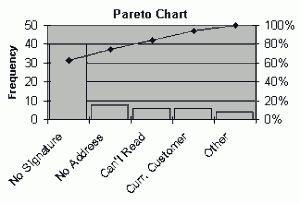Most of us have heard of the “80/20 Rule,” but how many of us have taken time to apply its lessons to our business?
The 80/20 Rule, in its most general form, says that 80% of you outcomes come from 20% of your inputs. It was invented by the 19th century Italian economist Vilfredo Pareto, who observed that 80% of Italy’s land was owned by 20% of its people.
In business, this has many applications. Which might be true for your business?
- 80% of your profit comes from 20% of your customers.
- 80% of your sales come from 20% of your product assortment.
- 80% of your complaints come from 20% of your customers.
- 80% of failures come from 20% of defects.

A Pareto Chart helps you prioritize by highlighting the critical issues. - ….
OK so what? Here’s how you use this knowledge to improve your business results.
Use the 80/20 Rule to focus your energy on the things that will have the highest impact on your bottom line. This can be counter-intuitive and actually feel quite risky. But it will produce the best results.
Here’s what I mean. Let’s say 80% of you profit comes from 20% of your customers. Well then, nearly 80% of your time should be spent on those 20% of customers. Instead, most of us dedicate “extra attention” to our top customers, but still spread the love pretty evenly. This creates opportunity for a competitor to steal your extremely valuable asset.
This feels scary and risky, because now you have 80% of your customers and barely any time left to service them all. But you are making an intentional decision to focus on the customers who bring in WAY more business. Weigh the risk of loosing an “average” customer to the risk of losing a top customer.
Here are some other questions to focus your actions based on the 80/20 Rule, for the other scenarios I mentioned above.
- If 80% of your sales come from 20% of your product assortment, are you focusing enough energy on that 20% of products? Is that part of your offering always up to date? Do you ever run out of stock? Can you sell other items closely related to those best-sellers?
- If 80% of your complaints come from 20% of your customers, are those customers worth serving? Are they worth all of your valuable time they’re taking? (I’ll write a future post about how to graciously fire a customer….)
- If 80% of failures come from 20% of defects, is your entire quality effort focused on fixing that critical 20% of defects? Or are you spending equal energy fixing all defects? Which is a better use of your time?
How have you used the 80/20 Rule to improve your business results? Share your thoughts in the comments.